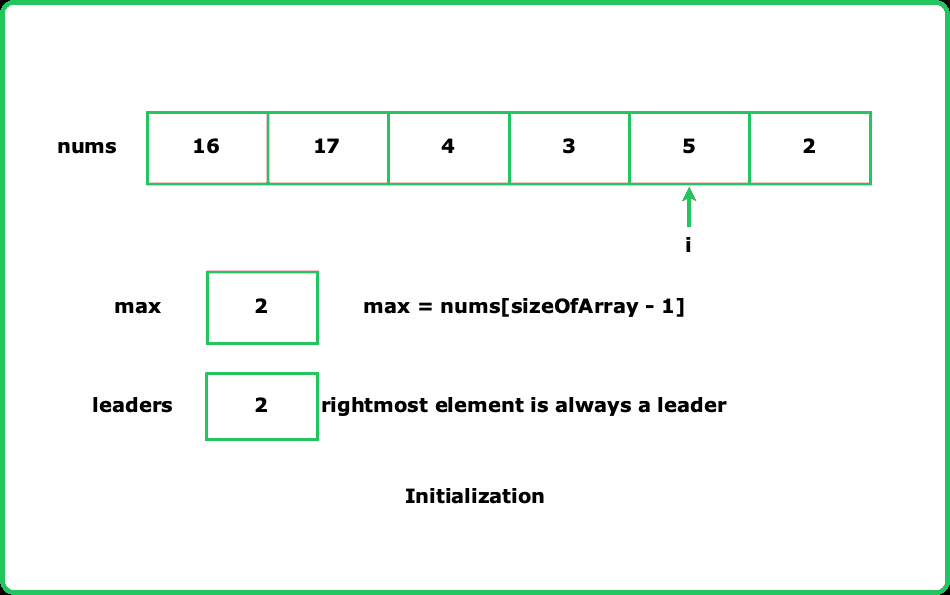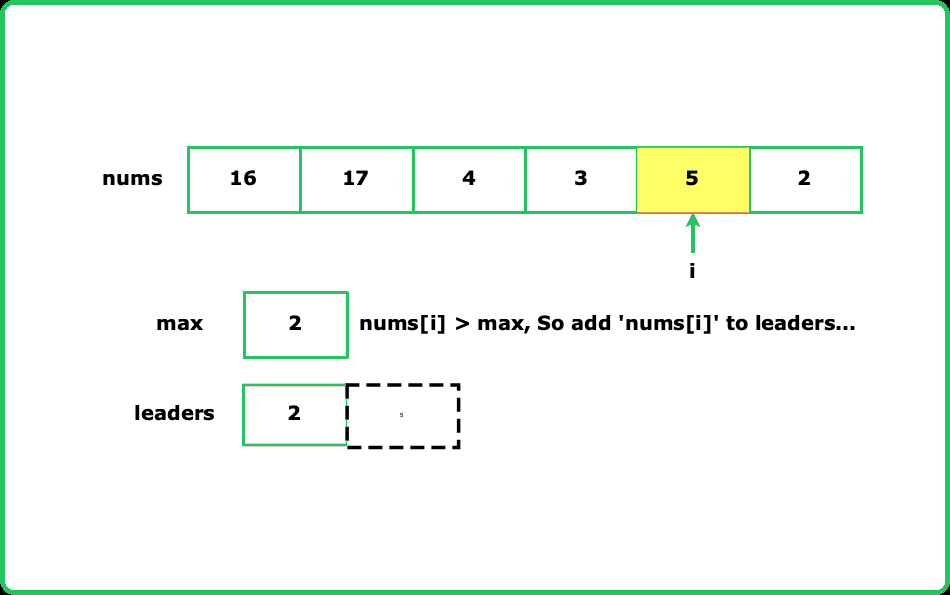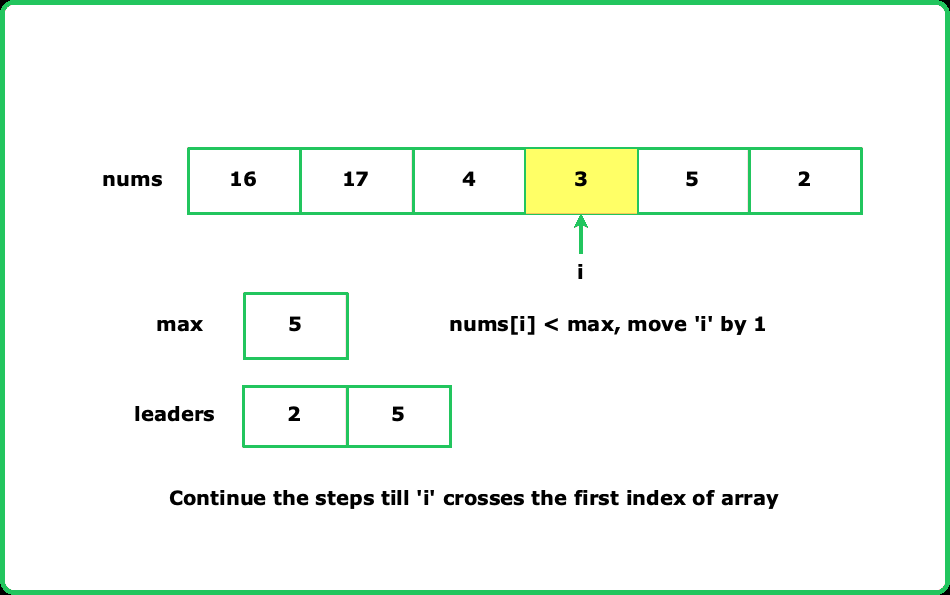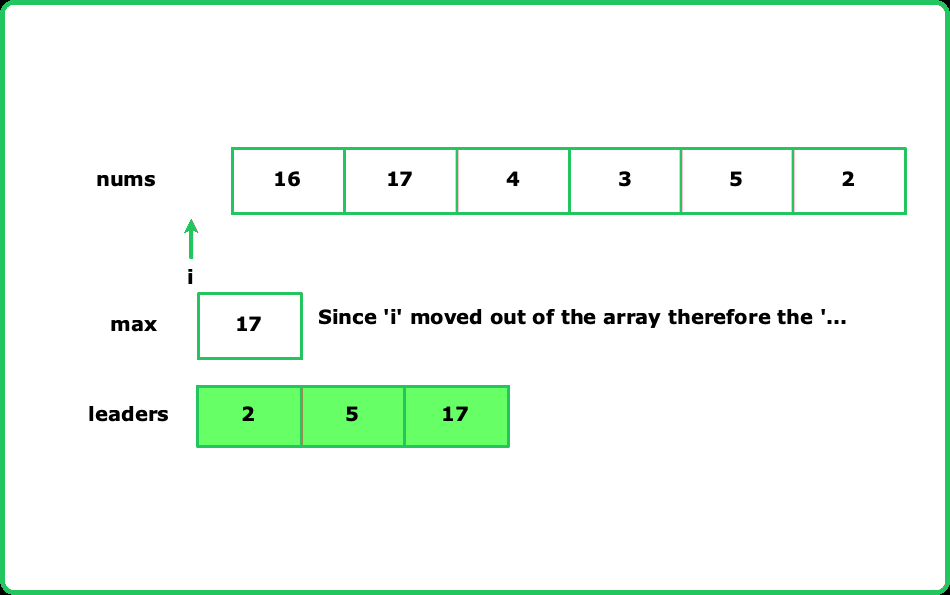12345678910111213141516171819202122232425262728293031323334353637383940414243444546474849505152
#include<bits/stdc++.h>
using namespace std;
class Solution {
public:
//Function to find leaders in an array.
vector<int> leaders(vector<int>& nums) {
vector<int> ans;
// Iterate through each element in nums
for (int i = 0; i < nums.size(); i++) {
bool leader = true;
/* Check whether nums[i] is greater
than all elements to its right*/
for (int j = i + 1; j < nums.size(); j++) {
if (nums[j] >= nums[i]) {
/* If any element to the right is greater
or equal, nums[i] is not a leader*/
leader = false;
break;
}
}
// If nums[i] is a leader, add it to the ans vector
if (leader) {
ans.push_back(nums[i]);
}
}
//Return the leaders
return ans;
}
};
int main() {
vector<int> nums = {1, 2, 5, 3, 1, 2};
// Create an instance of the Solution class
Solution finder;
// Get leaders using class method
vector<int> ans = finder.leaders(nums);
cout << "Leaders in the array are: ";
for (int i = 0; i < ans.size(); i++) {
cout << ans[i] << " ";
}
cout << endl;
return 0;
}
1234567891011121314151617181920212223242526272829303132333435363738394041424344454647484950
import java.util.*;
class Solution {
//Function to find leaders in an array.
public ArrayList<Integer> leaders(int[] nums) {
ArrayList<Integer> ans = new ArrayList<>();
// Iterate through each element in nums
for (int i = 0; i < nums.length; i++) {
boolean leader = true;
/* Check whether nums[i] is greater
than all elements to its right */
for (int j = i + 1; j < nums.length; j++) {
if (nums[j] >= nums[i]) {
/* If any element to the right is greater
or equal, nums[i] is not a leader */
leader = false;
break;
}
}
// If nums[i] is a leader, add it to the ans list
if (leader) {
ans.add(nums[i]);
}
}
// Return the leaders
return ans;
}
}
class Main {
public static void main(String[] args) {
int[] nums = {1, 2, 5, 3, 1, 2};
// Create an instance of the Solution class
Solution finder = new Solution();
// Get leaders using class method
ArrayList<Integer> ans = finder.leaders(nums);
System.out.print("Leaders in the array are: ");
for (int leader : ans) {
System.out.print(leader + " ");
}
System.out.println();
}
}
123456789101112131415161718192021222324252627282930313233343536373839
class Solution:
# Function to find leaders in an array.
def leaders(self, nums):
ans = []
# Iterate through each element in nums
for i in range(len(nums)):
leader = True
'''Check whether nums[i] is greater
than all elements to its right'''
for j in range(i + 1, len(nums)):
if nums[j] >= nums[i]:
'''If any element to the right is greater
or equal, nums[i] is not a leader'''
leader = False
break
# If nums[i] is a leader, add it to the ans list
if leader:
ans.append(nums[i])
# Return the leaders
return ans
# Main method
nums = [1, 2, 5, 3, 1, 2]
# Create an instance of the Solution class
finder = Solution()
# Get leaders using class method
ans = finder.leaders(nums)
print("Leaders in the array are: ", end="")
for leader in ans:
print(leader, end=" ")
print()
1234567891011121314151617181920212223242526272829303132333435363738394041
class Solution {
// Function to find leaders in an array.
leaders(nums) {
let ans = [];
// Iterate through each element in nums
for (let i = 0; i < nums.length; i++) {
let leader = true;
/* Check whether nums[i] is greater
than all elements to its right */
for (let j = i + 1; j < nums.length; j++) {
if (nums[j] >= nums[i]) {
/* If any element to the right is greater
or equal, nums[i] is not a leader */
leader = false;
break;
}
}
// If nums[i] is a leader, add it to the ans array
if (leader) {
ans.push(nums[i]);
}
}
// Return the leaders
return ans;
}
}
// Main method
let nums = [1, 2, 5, 3, 1, 2];
// Create an instance of the Solution class
let finder = new Solution();
// Get leaders using class method
let ans = finder.leaders(nums);
console.log("Leaders in the array are: " + ans.join(" "));



